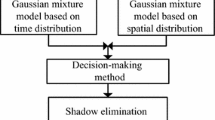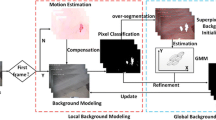Abstract
This paper proposes a simple yet effective background modeling method based on recurring patterns voting for moving object detection under challenging scenes. Our method performs the following two steps. First, we employ Gaussian Mixture Model (GMM) to generate the initial background probability map for each frame, in which the value of each pixel represents its probability belonging to the background. Second, we perform recurring patterns voting by employing the graph-based manifold ranking algorithm on the spatially constrained graph to refine the probability map. This prior bases on the observation that the same patterns tend to recur frequently in same semantic regions (background or foreground). We verify it in our problem by calculating the background-background, foreground-foreground and background-foreground densities on some video sequences with ground truths. Experimental results on public video sequences suggest that the proposed method significantly outperforms other moving object detection methods.





Similar content being viewed by others
References
Achanta R, Shaji A, Smith K et al (2012) SLIC superpixels compared to state-of-the-art superpixel methods. IEEE Trans Pattern Anal Mach Intell 34 (11):2274–2282
Barnich O, Van Droogenbroeck M (2011) ViBe: a universal background subtraction algorithm for video sequences[J]. IEEE Trans Image Process 20(6):1709–1724
Bouttefroy PLM, Bouzerdoum A, Phung SL et al (2010) On the analysis of background subtraction techniques using Gaussian mixture models[C]. In: 2010 IEEE international conference on acoustics speech and signal processing (ICASSP). IEEE, pp 4042–4045
Bouwmans T (2012) Background subtraction for visual surveillance: a fuzzy approach[J]. Handbook Soft Comput Video Surveillance 5:103–138
Candés EJ, Li X, Ma Y et al (2011) Robust principal component analysis?[J]. J ACM (JACM) 58(3):11
Chan AB, Mahadevan V, Vasconcelos N (2011) Generalized Stauffer–Grimson background subtraction for dynamic scenes[J]. Mach Vis Appl 22(5):751–766
Dalal N, Triggs B (2005) Histograms of oriented gradients for human detection[C]. In: IEEE computer society conference on computer vision and pattern recognition, CVPR 2005, vol 1. IEEE, pp 886–893
Dempster AP, Laird NM, Rubin DB (1977) Maximum likelihood from incomplete data via the EM algorithm[J]. J R Stat Soc Ser B Methodol 1–38
Derpanis KG, Lecce M, Daniilidis K et al (2012) Dynamic scene understanding: the role of orientation features in space and time in scene classification[C]. In: 2012 IEEE conference on computer vision and pattern recognition (CVPR), vol 2012. IEEE, pp 1306–1313
Faktor A, Irani M (2014) Video segmentation by non-local consensus voting[C]. BMVC 2(7):8
Goyette N, Jodoin PM, Porikli F et al (2012) Changedetection. net: a new change detection benchmark dataset[C]. In: 2012 IEEE computer society conference on computer vision and pattern recognition workshops (CVPRW). IEEE, pp 1–8
Guo C, Liu D, Guo YF et al (2014) An adaptive graph cut algorithm for video moving objects detection[J]. Multimed Tools Appl 72(3):2633
Hammami M, Jarraya SK, Ben-Abdallah H (2013) On line background modeling for moving object segmentation in dynamic scenes[J]. Multimed Tools Appl 1–28
Jalal AS, Singh V (2014) A framework for background modelling and shadow suppression for moving object detection in complex wavelet domain[J]. Multimed Tools Appl 73(2):779
Jian M, Lam KM, Dong J (2014) Facial-feature detection and localization based on a hierarchical scheme[J]. Inf Sci 262:1–14
Jian M, Lam KM, Dong J et al (2015) Visual-patch-attention-aware saliency detection[J]. IEEE Trans Cybern 45(8):1575–1586
KaewTraKulPong P, Bowden R (2002) An improved adaptive background mixture model for real-time tracking with shadow detection[J]. Video-Based Surveillance Syst 1:135–144
Kulchandani JS, Dangarwala KJ (2015) Moving object detection: review of recent research trends[C]. In: 2015 international conference on pervasive computing (ICPC). IEEE, pp 1–5
Li C, Lin L, Zuo W et al (2016) An approach to streaming video segmentation with sub-optimal low-rank decomposition[J]. IEEE Trans Image Process 25(5):1947–1960
Li C, Lin L, Zuo W et al (2015) Sold: sub-optimal low-rank decomposition for efficient video segmentation[C]. In: Proceedings of the IEEE conference on computer vision and pattern recognition, pp 5519–5527
Li C, Wang X, Zhang L et al (2017) Weighted low-rank decomposition for robust grayscale-thermal foreground detection[J]. IEEE Trans Circuits Syst Video Technol 27(4):725–738
Li L, Huang W, Gu IYH et al (2004) Statistical modeling of complex backgrounds for foreground object detection[J]. IEEE Trans Image Process 13(11):1459–1472
Liu X, Xu Q, Ma J et al (2014) MsLRR: a unified multiscale low-rank representation for image segmentation[J]. IEEE Trans Image Process 23(5):2159–2167
Pilet J, Strecha C, Fua P (2008) Making background subtraction robust to sudden illumination changes[J]. In: Computer vision–ECCV 2008, pp 567–580
Shakeri M, Zhang H (2016) COROLA: a sequential solution to moving object detection using low-rank approximation[J]. Comput Vis Image Underst 146:27–39
Song J, Gao L, Nie F et al (2016) Optimized graph learning using partial tags and multiple features for image and video annotation[J]. IEEE Trans Image Process 25 (11):4999–5011
Stauffer C, Grimson WEL (1999) Adaptive background mixture models for real-time tracking[C]. In: IEEE computer society conference on computer vision and pattern recognition, vol 2. IEEE, pp 246–252
Yubing T, Cheikh FA, Guraya FFE et al (2011) A spatiotemporal saliency model for video surveillance[J]. Cogn Comput 3(1):241–263
Tu Z, Abel A, Zhang L et al (2016) A new spatio-temporal saliency-based video object segmentation[J]. Cogn Comput 4(8):629–647
Walha A, Wali A, Alimi AM (2015) Video stabilization with moving object detecting and tracking for aerial video surveillance[J]. Multimed Tools Appl 74(17):6745
Wren CR, Azarbayejani A, Darrell T et al (1997) Pfinder: real-time tracking of the human body[J]. IEEE Trans Pattern Anal Mach Intell 19(7):780–785
Xu D, Ricci E, Yan Y et al (2015) Learning deep representations of appearance and motion for anomalous event detection[J]. arXiv:1510.01553
Zheng A, Zhang L, Zhang W et al (2017) Local-to-global background modeling for moving object detection from non-static cameras[J]. Multimed Tools Appl 76(8):11003–11019
Zhou D, Weston J, Gretton A et al (2004) Ranking on data manifolds[C]. In: Advances in neural information processing systems, pp 169–176
Zhou X, Yang C, Yu W (2013) Moving object detection by detecting contiguous outliers in the low-rank representation[J]. IEEE Trans Pattern Anal Mach Intell 35 (3):597–610
Acknowledgments
This work was supported in part by the National Natural Science Foundation of China under Grant 61472002, in part by the Natural Science Foundation of Anhui Higher Education Institution of China under Grant KJ2017A017 and in part by the Co-Innovation Center for Information Supply & Assurance Technology of Anhui University under Grant Y01002449.
Author information
Authors and Affiliations
Corresponding author
Rights and permissions
About this article
Cite this article
Li, C., Bao, Z., Wang, X. et al. Moving object detection via robust background modeling with recurring patterns voting. Multimed Tools Appl 77, 13557–13570 (2018). https://doi.org/10.1007/s11042-017-4975-4
Received:
Revised:
Accepted:
Published:
Issue Date:
DOI: https://doi.org/10.1007/s11042-017-4975-4




